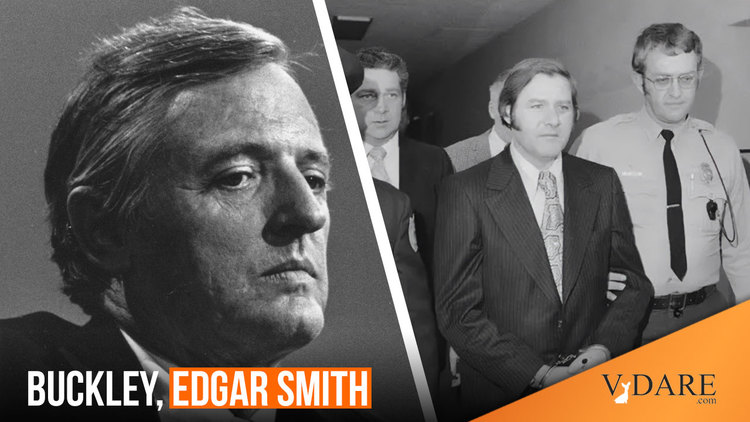
William F. Buckley And The Murderer
02/25/2022
The 1960s were much like the 2020s in terms of credulity about the innocence of criminals. But nobody remembers that. Thus, from a New York Times book review:
How a Death-Row Inmate’s Embrace of Conservatism Led to His Release
Reviewed by Katherine Dykstra
Feb. 22, 2022SCOUNDREL
How a Convicted Murderer Persuaded the Women Who Loved Him, the Conservative Establishment and the Courts to Set Him Free
By Sarah WeinmanIn a country that incarcerates Black people at a rate five times that of white people, one thing is uncomfortably clear: The truth matters less than who controls the narrative. The person whose perspective is amplified is more often the one believed. Just ask Kyle Rittenhouse, the white Fox News favorite who walks free despite shooting three people during a protest against police violence. Or Anthony Broadwater, the Black man whose claims of innocence fell on deaf ears during all 16 years of his wrongful conviction for the rape of the writer Alice Sebold.
Sarah Weinman’s latest true-crime book, “Scoundrel,” is about who receives the benefit of our doubt and the privileges that attend that trust, whether or not it is warranted.
In 1957, Edgar Smith, a 23-year-old former Marine who was both a husband and a new father, confessed to the bludgeoning murder of 15-year-old Vickie Zielinski in New Jersey. After deliberating for two hours, a jury convicted him. The judge sentenced him to death and he was sent to Trenton State Prison.
What interests Weinman, who writes the Crime column for The New York Times Book Review, is not the murder but what transpired in its wake. Through a confluence of events, William F. Buckley Jr., the founder of National Review and one of the architects of the 20th-century conservative movement, learned that Smith was a fan of his publication. Flattered, Buckley began to mail the inmate the latest issues. These communications initiated a relationship that would add up to nine years and 1,500 pages of correspondence — and, ultimately, Smith’s release from prison.
As the two men got to know each other, Buckley not only came to believe that Smith had been wrongfully convicted but took up his cause, publishing a 12,000-word essay in Esquire making the case for Smith’s innocence; with his fee, he seeded a legal fund for Smith’s defense. The essay drew the attention of Sophie Wilkins, an editor at Alfred A. Knopf, who began her own exchange with Smith and eventually published his account of the murder and its fallout, the best-selling “Brief Against Death.”
When Buckley promoted Smith’s book on TV, it paved the way for his pen pal to become the first convicted murderer nominated to join PEN America. The publicity turned Smith into a cause célèbre and led to the overturning of his conviction. Buckley picked Smith up from prison in a limousine, plied him with rosé and roast beef, and drove him directly to a sound studio to tape two episodes of his public affairs show, “Firing Line.”
Smith, who was by then 40 and divorced, married 19-year-old Paige Hiemier, and the couple moved to California, where Smith enjoyed his literary fame — until he attacked another woman.
There were two other similar fiascos in the same era involving superstar writers helping free prisoners who soon committed more violent crimes. Besides William F. Buckley and Edgar Smith from 1965-1971, there was Norman Mailer and Jack Abbott in the late 1970s-1981. And there was Sophie’s Choice author William Styron (assisted by an undergrad George Will) and Benjamin Reid in the early 1960s.
Buckley’s Smith was white. But Mailer’s Abbott was Eurasian. And Styron’s and Will’s Reid was black. So, I’d say this phenomenon had less to do with Systemic Racism than with the Spirit of the Age.
Mailer’s comeuppance came last, in 1981, by which point lots of people were sick of the long-reigning soft on crime attitudes of the Sixties, so it’s the most notorious. (The reviewer fails to mention it, but quite a few people call it out in the comments.) The Styron/Will embarrassment came first in the liberal Sixties, so it is almost completely forgotten. (Nobody mentions it in the comments.)
See, earlier:
- Edgar Smith (And WFB) Remembered
- Writers, Released Murderers, And Recidivism — How Often Did This Happen?
- Buckley, Mailer, Styron: American Writers and Their Pet Criminals
- Buckley, Edgar Smith And Norman Mailer — Buckley Was Gullible About A Killer, But Mailer Got His Guy Out Of Jail Even Though He Knew He Was Guilty
- WASHINGTON POST Story On Edgar Smith Reveals Typical Liberal Thinking About Crime — Girl’s Murder Was An "Ill-Fated Encounter"
- More On Edgar Smith: “Ill-Fated Encounter”? Try Complete “Decerebration”
- PEOPLE Magazine And Writers' Pet Felons
- Murderers With Fancy Prose Styles
